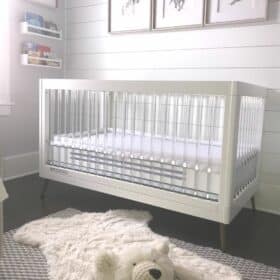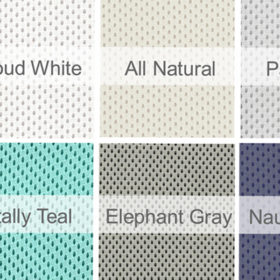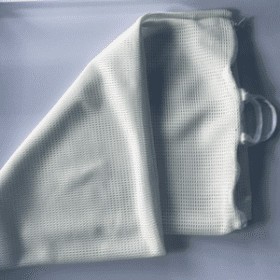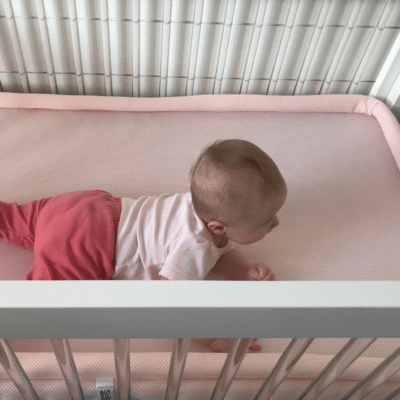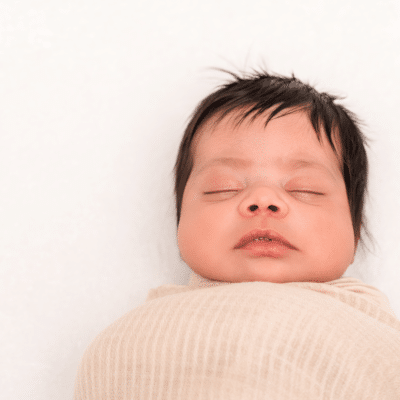No products in the cart.
Baby Rolling Over – What You Need to Know to Keep Them Safe
Many new parents ponder the question, “when will my baby roll over.”
If your little one is starting to get really good at tummy time, you might start wondering when should babies start rolling over. Rolling over is one of the first major physical milestones a baby goes through.
Before they learn to crawl or walk, they will learn to roll over. It may seem scary at first. but you can start doing things now to help them learn to roll over safely.
These adjustments are small and easy and will give you the peace of mind you need to help your little gymnast flourish. This article explains all of the details so that you can be prepared to help your little one accomplishes this major task. But more important, keep them safe.
We explain the dangers that can be lurking when your baby starts to roll over. Having this information and putting simple procedures in place will keep your baby safe.
It’s pretty scary when you find your baby rolling over onto his/her stomach while sleeping but does not have the ability to roll back.
Will my baby roll over from their back to their tummy or tummy to back first?
As previously mentioned, rolling over is one of the first major physical milestones for a baby. It is a lot of work for them to roll those big bellies over. They have to build a lot of muscle in their neck, arms, back, and core.
Most babies learn to roll from their tummy to their back first. Babies need time and practice to build up the muscles in their back, arms, and neck. This is why tummy time is crucial to helping your baby learn to roll over. Rolling from back to tummy is typically later because this takes significantly more strength in the neck back, and core.
You may be waiting for your child to roll over or you may be surprised when they do, but either way, just know they need time to practice!
Infants first learn to roll from their tummy to back around 4 months old. Some babies may even start early rolling at around 2 months old. Then, after he/she masters rolling tummy to back, they can start learning back to tummy. They usually can roll all the way around by 6 months old.
Building up muscle
As your baby spends more time on their stomach, they will build up those leg and arm muscles until finally they kick or flail until they start rolling side to side and eventually over onto their back. If your baby hasn’t rolled over, sat up, or tried to scoot by 7 months, talk to your pediatrician about it.
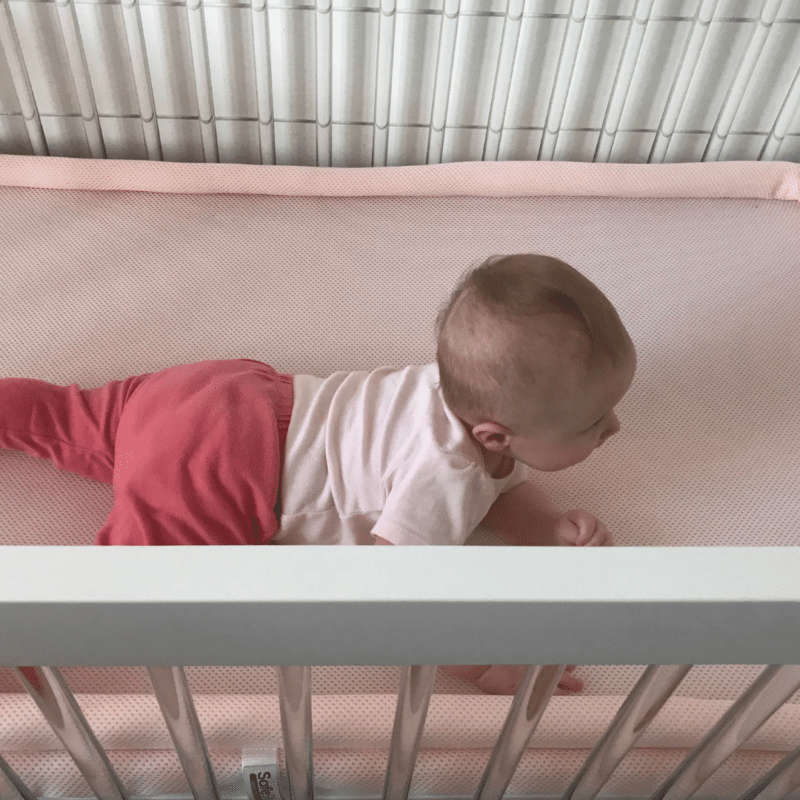
The natural progression
According to medically reviewed studies, babies begin developing their coordination and strength to achieve developmental milestones when they are born. At first, babies do not have much head or neck control. That is why it is important to support their heads during this time.
At first you will notice you newborn sleeping on their back with head to the side or sleeping with their head straight. Before you know it, your baby will be sleeping on their side. And then rolling over. And most likely sleeping on their belly. This can be dangerous so we will discuss it later in our article.
You want to make sure to give your newborn plenty of tummy time. Tummy time is crucial for proper baby development. Even newborns benefit from tummy time. It helps build those muscles we spoke about.
Simply start your newborn with tummy time for short sessions a few times a day. These sessions can be for just a few minutes.
Between 1 to 2 months
Your baby will show signs of trying to lift their head when they are placed on their stomach, but they will be struggling. Don’t worry. This is normal. You may even notice your baby beginning to turn head briefly.
Your baby may seem uncomfortable or even fussy. Don’t get discouraged. Encourage your baby to stick with for 2-3 minutes.
Between 3 to 4 months
Around 3 to 4 months, you may notice your baby trying to do mini pushups during tummy time. This movement usually involves them lifting their head and shoulders up using their arms for support. This is great progress. Your baby is strengthening the muscles he/she will need to start rolling over.
It not uncommon for your baby to roll for the first time during supervised tummy time. Don’t panic if your baby gets a little startled when he/she suddenly ends up on their back. You will be elated at your little one’s accomplishment. But remember, when a baby first starts rolling over, it can be a little scary for your baby. This is only temporary. They too will become happy and confident about their new skill.
Around 5 to 6 months
At around 5 months old your baby should be able to lift his/her head, push up on their arms lifting their chest off the ground. They should also be able to arch their back. They will certainly be able to kick their legs. Some babies may even appear to be swimming.
All this activity is building up your baby’s muscles they need to roll over. Soon they will be rolling over n both directions. This usually occurs around 5 or 6 months old.
You will also notice your baby is sitting up. It won’t be long before your baby begins to scootch across the floor. They begin finding ways to explore their surroundings. Some babies use rolling as their primary mode of transportation, while others move right into a craw. If your baby is not very mobile, there is no reason to panic. As long as your child continues to gain new skills and shows interest in getting around, you have no need to worry.
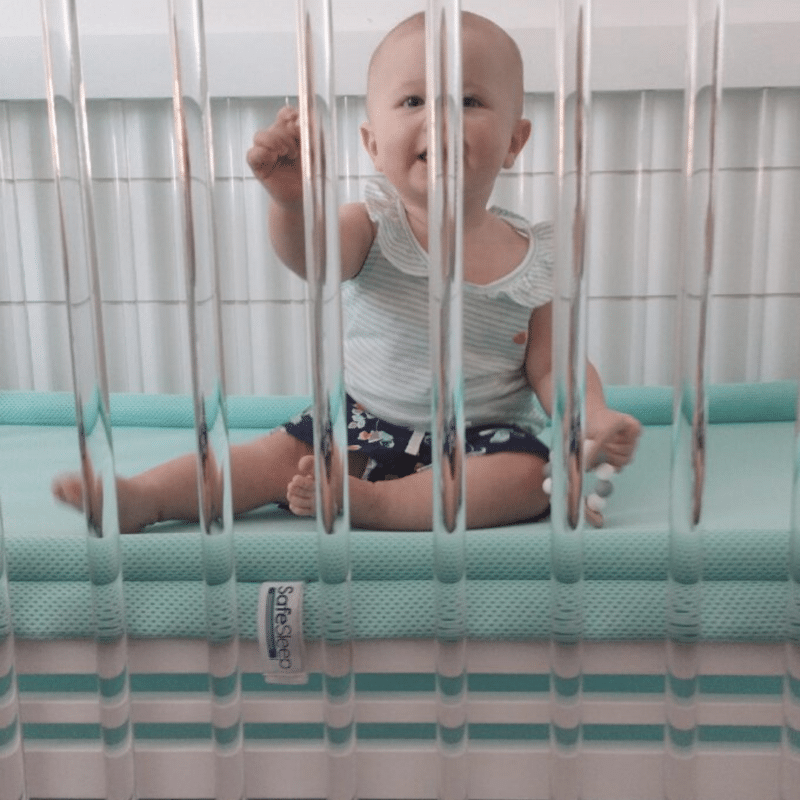
Should I help my baby learn how to roll over?
Yes. Tummy time is the perfect setting to help your baby learn to roll over. When in tummy time, encourage your baby to lift their head up off of the surface and turn to one side by talking to them and having them try to follow your voice. This motion of lifting the head and turning is fundamental to eventual rolling over.
You can also use toys or items that make noise. The key is to get your baby’s attention and have them follow your verbal or non-verbal commands to lift their head or turn.
Once they have mastered this, help your baby raise their head and chest up off the surface by placing their arms in front of them under their shoulders so they can easily push up using their arms.
Don’t panic
Don’t panic if your baby isn’t rolling over by 6 months. Some babies never roll over, or never roll over from back to tummy
Rolling over for baby takes head control and strong neck, arm, core, and back muscles. Your baby starts developing this coordination and muscle control from the time they are first born. Consequently, it is a work in process.
If this is your first child, it might look a little weird to you or even make you anxious. It may also startle your baby. These next steps will help both you and your baby relax and enjoy the journey. The key is to play it safe so your baby can explore safely.
Create a safe environment
Make sure that you place your baby in a safe and comfortable place for tummy time. You can choose a carpeted floor, a rug, or cushioned mat. At first, they won’t be able to roll far. However, before you know it, they will be rolling quickly. This is why it is best to use a floor instead of an adult bed for tummy time. The crib is also a safe place to practice tummy time.
Remember, tummy time is always a supervised time with your baby.
Be sure to avoid harder surfaces where your baby can hit his/her head or small. Also, keep in mind that elevated places like a changing table can be dangerous for a rolling baby. Consequently, you will need to pay extra attention during changing sessions once your baby begins to roll. Babies become mobile and may try to escape the dreaded diaper change.
Create an environment they want to explore
Make sure your baby has an environment they want to explore. Use things like colors and toys to get them to move in a specific direction. A play gym is perfect for this stage. You can set them down on the mat on their bellies, and the toys above their head will encourage them to look up and roll over to reach for them.
Another option is a more colorful rug, toys that are just out of reach on the floor, or even something you can hold and play with while they watch such as a stuffed animal or rattle.
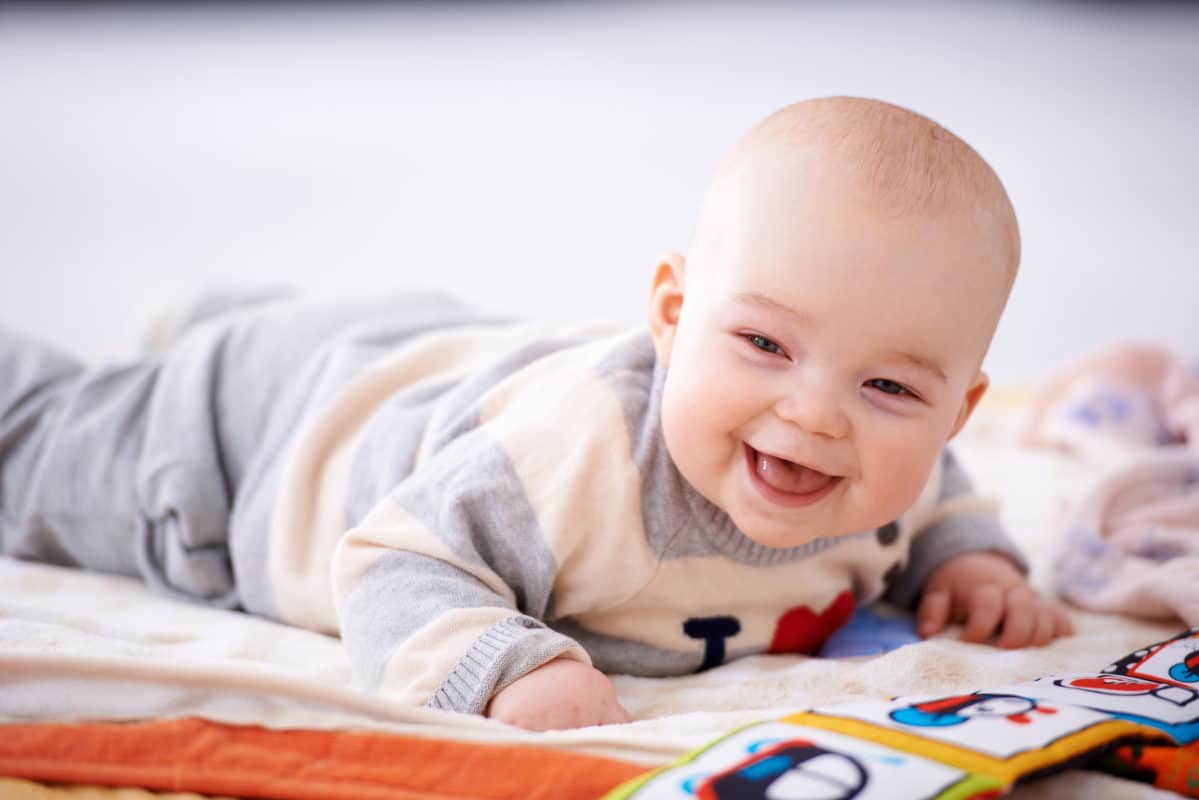
Practice tummy time often
Tummy time is crucial to developing those core muscles your baby uses to hold their head up, sit up, crawl, and roll over. It’s important to practice tummy time at least once per day. You can start your baby off with multiple smaller sessions of just a few seconds, say thirty seconds, and build them up by adding a minute every day until you get to just one or two sessions totaling 20 minutes.
Do I need to worry about my baby rolling over in their sleep?
It can be exciting when your baby begins rolling over, but it can also cause anxiety. Many parents worry about their baby rolling over in their sleep. Moreover, it creates a lot of anxiety if your baby is sleeping face down.
The American Academy of Pediatrics and the Centers for Disease Control instruct parents to place their babies to sleep on their backs to reduce the risk of sudden infant death syndrome (SIDS).
According to the CDC, about 3,600 babies die from SIDS in the United States every year. Prone or face-down sleeping increases the risk of infants re-breathing carbon dioxide that they exhale into their sleep surface.
A high level of carbon dioxide can suppress the infant’s breathing center.
To find out more about what to do when your baby is sleeping face down read our article, Baby Sleeping Face Down – What to Do.
What should I do if my baby begins rolling over in their sleep?
The first step to safe sleep is to create a safe environment for your child to sleep in. The important thing is that your baby starts every sleep time on his or her back to reduce the risk of SIDS. There should be no soft objects, toys, crib bumpers, or loose bedding under baby, over baby, or anywhere in baby’s sleep area.
Next, make sure that their mattress is safe and reliable. The SafeSleep® Breathe-Through Crib Mattress is rated as the safest breathable crib mattress. It’s the #1 Pediatrician recommended crib mattress for safe sleep. It addresses all the safety, health, and sanitary issues associated with other traditional, organic, and other breathable crib mattresses as well.
A completely breathe-through crib mattress keeps rolling babies safe
Testing shows 100% oxygen rich air when breathing through the SafeSleep® crib mattress which means that your baby breathes normally even if they are sleeping face down. It’s that extra bit of peace and reassurance that you need to know your baby is getting the best sleep possible.
Your baby will eventually roll over during the night. And when this happens, using a SafeSleep® Breathe-Through Crib Mattress gives parents peace of mind knowing that their baby can breathe even when face down.
Traditional crib mattresses with vinyl covers, cores, quilted toppers, and even loose-fitting sheets have been known to trap carbon dioxide; this is especially concerning when your baby begins rolling over.
The SafeSleep® Breathe-Through Crib Mattress significantly reduces the risk of carbon dioxide rebreathing even if the infant is face down or tummy sleeping.
Need more information on when our baby can sleep on their stomach? Check out our article on When Can Babies Sleep on Their Stomach?
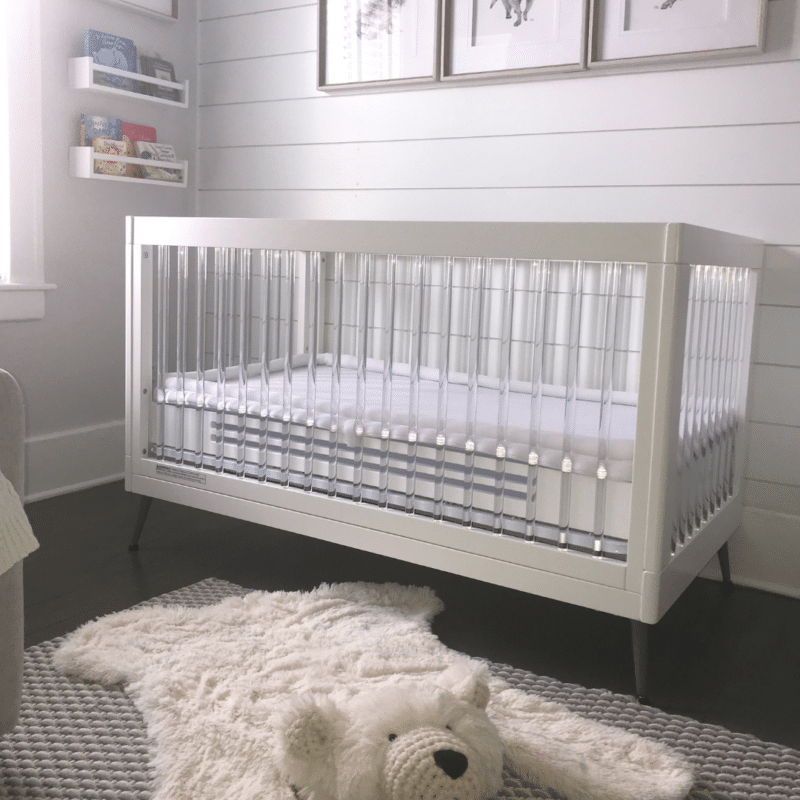
Using scientific research here is what we have known about crib mattress and their role in SIDS
Babies sleeping on their stomach is a known risk factor for SIDS, and face-down sleep increases this risk further (1).
Even after a thorough investigation, it can be hard to tell SIDS apart from other sleep-related infant deaths like overlay or suffocation. These deaths are often unwitnessed. There are no tests to tell SIDS apart from suffocation. To complicate matters, people who investigate SIDS deaths may report the cause of death in different ways and may not include enough information about the circumstances of the event from the death scene (3).
Infants in the face down position on fiberfill crib mattresses, quilted surfaces, soft surfaces, pillow-like surfaces, vinyl pads, mattresses filled with tea tree bark and other natural fibers, and even surfaces that claim to be breathable, show increased risk of rebreathing of carbon dioxide. Rebreathing leads to hypoxia, a condition associated with SIDS (5-9).
Rebreathing
According to Dr. James Kemp and Dr. Brad Thach (top SIDS researchers), some bedding materials may act to retard the dispersal of exhaled gasses (carbon dioxide). These exhaled gases become trapped near a face down infant’s mouth. With each subsequent breath, the infant takes in an air mixture which is progressively less adequate to sustain life. The more conducive an item is to rebreathing (retaining carbon dioxide), the more hazardous the item would be (8).
It is important to keep fresh oxygen flowing to a sleeping baby and avoid anything in the crib that can cause the build-up of carbon dioxide and heat.
Using scientific research, here is what we still do not known about crib mattress and their role in SIDS
What causes SIDS. SIDS is a diagnosis of exclusion when no cause of death can be scientifically determined (2).
We do not know which infants are more likely to rebreathe carbon dioxide. Most infants will turn their head to avoid “rebreathing” but some do not. We have no way of testing to find out which infants are “vulnerable” so all infants remain at risk (10).
Recent research points to finding a possible biological marker that may detect which infants are vulnerable. This research was published May 6, 2022 in eBioMedicine. The research concludes that an enzyme, BChE, may identify infants who are vulnerable to SIDS. This vulnerability is listed as a failure to arouse or wake when the infant isn’t getting fresh oxygen.
Even though media hype listed the study as finding the “cure” for SIDS, we are not there yet. Even the study’s author, Dr. Carmel Harrington was surprised by the claims in the media. The possible identification of a biological marker is a set in the right direction.
Nothing we can give to infants to avoid SIDS
However, there is nothing that can be given to an infant who may be identified as being more susceptible to SIDS or process to change the outcome.
We do not know the carbon dioxide retention level of all crib mattresses and sleep surfaces that claim to be “breathable.” As scientific studies show, some air permeable crib mattresses and sleep surfaces that have porous cores, actually retain higher levels of carbon dioxide than thick fiberfill materials (5-8).
No studies exist comparing infants who sleep on various crib mattresses to see which one has fewer SIDS deaths. No published studies or valid scientific testing is available that shows if one crib mattress or sleep surface has a lower/higher SIDS risk.
These gold standard studies do not exist for any of the AAP Task Force recommendations and likely never will; it is not feasible to enroll the number of infants required to get sufficient data. To perform suffocation testing, unethical testing would have to be performed on infants to find out the “suffocation threshold” (4).
Therefore, we must continue to focus on reducing key SIDS risk factors.
Using scientific research, here is what we now know about Crib Mattress and SIDS
Scientific evidence shows some air permeable mattresses provide a “significant” decreased risk of rebreathing of carbon dioxide (5,6,7,8,9,11).
The SafeSleep® Breathe-Through Crib Mattress has been tested for carbon dioxide retention and has a ten-fold decrease in carbon dioxide retention when compared to a fiberfill mattress.
It takes 2 minutes for carbon dioxide to dissipate on a firm crib mattress; it takes less than 1/2 a second for it to dissipate on the SafeSleep® Crib Mattress (11).
An infant takes a breath every 1-2 seconds, meaning the carbon dioxide (poisonous gasses) on the SafeSleep® Breathe-Through mattress would be gone before the infant takes their next breath of air – even if face straight down (12).
About the SafeSleep Breathe-Through Crib Mattress and how it can protect a baby who is rolling over
A proven way to reduce the risk of infant deaths from suffocation is by using a crib mattress infant can breathe through normally should they become face down. Also, a crib mattress that does not allow CO2 to accumulate. If CO2 cannot accumulate, the risk of rebreathing is gone.
The key attribute of the SafeSleep crib mattress is not what’s in it, but rather what is no. The SafeSleep mattress has no fill or core. Instead, it is an open box design with side opening cut out of the sides to create passive airflow in and out of the mattress.
Next, this mattress features a unique 3D Open-Cell Surface design. This design allows air to pass freely through the surface. It also features a locking bar system that keep the surface of the mattress taut and free from folds that may inhibit breathing.
Picture yourself breathing through a 1/8” piece of fabric with millions of tiny holes. Air is unobstructed and flows freely. Carbon dioxide flows away quicker than a baby takes in their next breath of air. This revolutionary design eliminates the risk of both suffocation and rebreathing of carbon dioxide.
Additionally, the SafeSleep Breathe Through Crib Mattress doesn’t contain all of the toxic chemicals or even the natural fibers that are known to trap harmful CO2 that can contribute to hypoxia. Matter of fact, our mattresses are OEKO-TEX certified to contain no harmful chemicals.
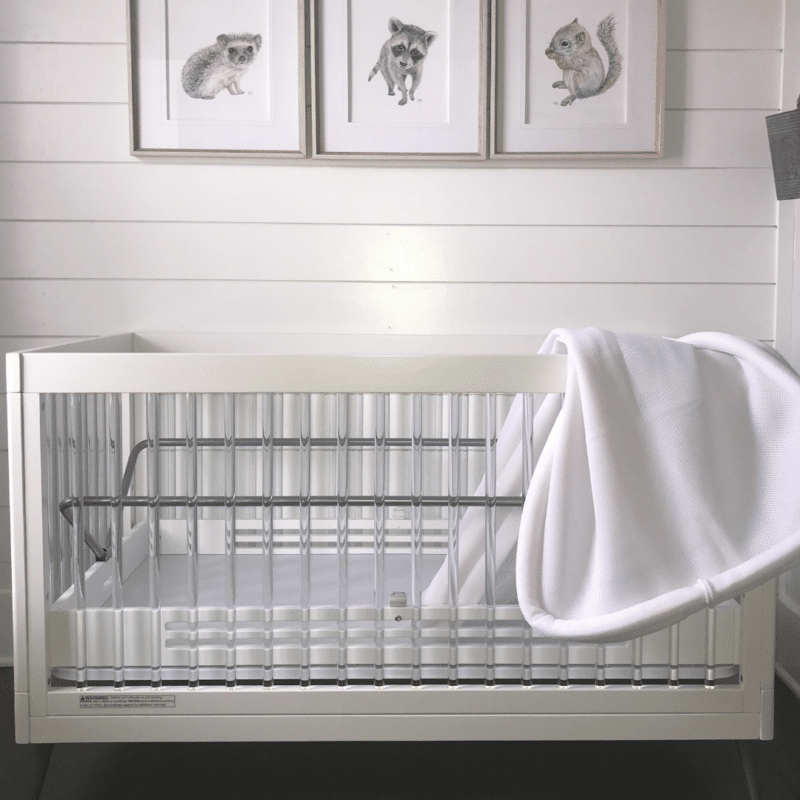
Baby rolling over in a bassinet is a danger
Many parents start using with a bassinet. Parents realize, after all, that it is essential that their new little bundle of joy have a safe and comfortable place to sleep the minute they come home from the hospital.
The baby bassinet has increased in popularity as the go-to option for newborns. In fact, its usage has more than doubled in recent years.
Why the increase in popularity of bassinets?
Baby bassinets are convenient. A mom can set a bassinet up right next to her bedside, making it much easier to monitor the baby and do those frequent late-night feedings that are necessary the first few months of a baby’s life.
Bassinets are more mobile. Those first months with our newborn, we’re attached to them constantly (often, literally). The bassinet allows us to keep our babies near us when we might need to move to another room, like, say, to the family room to do laundry.
They are smaller and more comfortable for newborns. Your newborn likes the feeling of being snug, as it simulates the feeling of being in the womb. Bassinets are, on average, only 15” x 30” big, compared to the average size of 51” x 28” for cribs.
Bassinets are also generally much less expensive than a crib and are only used for a few months. Using a bassinet for a few months can give you more time to decide on which crib you want to commit to for your baby. Cribs can be used for a lot longer than bassinets, which makes it a much bigger commitment.
When should the baby move out of a bassinet?
Because they are so convenient and comfortable, bassinets are a great option for newborn babies and their mothers.
First, is if baby is literally too big for the bassinet. Meaning, your baby exceeds the weight limit set by the bassinet’s manufacturer, or your baby just doesn’t have much room to move around in the bassinet.
Bassinets should clearly indicate their weight limits in their information guides, and these limits vary depending on the bassinet. On average, a baby’s weight should not exceed 15 pounds in a bassinet, though it can be as low as 10 pounds and as high as 20 pounds for some.
Secondly, a baby has become too big for a bassinet once they are able to roll over on their own. Rolling over is a clear indication that baby needs to be moved to a crib.
Why is rolling over dangerous for babies in a bassinet?
A baby rolling overs in a bassinet can be especially dangerous. A baby can inadvertently roll itself into an unsafe situation that can increase the risk of dying of SIDS or suffocation.
As we mentioned, when you baby rolls from their back to their stomach, they may not have the strength or ability to roll back onto their back. This can be especially problematic if the rollover happens in the middle of the night during sleeping hours when no one is awake or available to put your baby on their back again.
Because a bassinet is smaller than a crib, when a baby rolls over in a bassinet their faces are more likely to come into contact with the sides of the bassinet or be stuck face down on the mattress of the bassinet.
When a baby rolls over, its poor neck control means that it is not able to move or lift its head. As the baby’s face presses into the surface of the mattress or cloth, there is not only a buildup of carbon dioxide from the exhalation of breath, but there is a lack of oxygen being breathed back in. This is a type of suffocation, known as hypoxia, that can result.
More and more bassinets nowadays are being made with breathable mesh on the sides of the bassinet, which is ideal. The mesh should allow the baby to breathe when it is contact with it. A roll over that presses the baby’s face against a non-breathable fabric can increase the baby’s risk of dying of SIDS or suffocation.
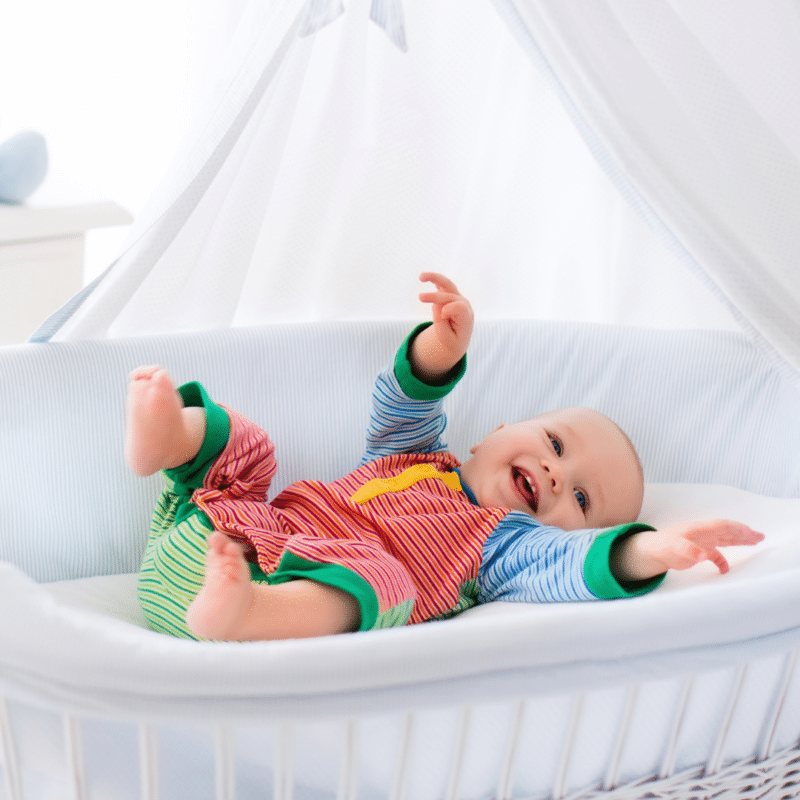
Are there other precautions I need to take to keep my baby safe once my baby can roll over?
One of the leading causes of injuries to infants is a fall from an elevated surface such as a parent’s bed or a changing table. This often occurs in a split second when a parent sets their baby down and the baby unexpectedly rolls for the first time.
Unfortunately, the roll may be right off of the bed or changing table onto the floor. To prevent this type of injury always keep one hand on your baby when they are on an elevated surface without protective baby-safe side rails or netting regardless of their age.
The dangers of swaddling when your baby begins rolling over
When it comes to swaddling, it’s important to be aware of the risk.
As mentioned above, babies who are swaddled can be at a higher risk of SIDS. In the United States, there are around 3400 sudden unexpected infant deaths (SUID) each year.
Swaddling too loosely can allow for their arms to come free, leaving excess blanket to cover their mouth or nose. Face covering can cause suffocation. This is especially true when your baby is beginning to develop the muscles need to roll over.
Swaddling is dangerous if you baby rolls over for obvious reasons. Being swaddled prevents your baby from using his arms to help him to get into a different position or lift his neck and head.
There is a big risk that a swaddled baby trying to roll over can land in a position that restricts their breathing. This happens if they are not on a crib mattress they can breathe-through. If swaddle, and your baby rolls over on a fiber filled surface, they can be stuck face down and suffocate. Also, even if their head is turned to the side, they are at risk of rebreathing their carbon dioxide that gets stuck in the fiber fill or sheets.
In fact, according to research infants who sleep on their back and roll to their stomach for the first time (13) have a decreased ability to escape an asphyxiating environment (suffocation and rebreathing CO2). The study concludes that infants who do not normally sleep on their stomach and roll over have a 20% risk of SIDS. This percentage jumps to 40% when the baby is swaddled.
As a side note, this testing was conducted using 38 infants on a standard fiber fill crib mattress.
Once your baby is showing signs of rolling, such as sleeping on their side, it’s time to transition out of the swaddle.
Read more about when you should stop swaddling your baby. which includes great advice from our medical professionals on how to safely transition your baby out of their swaddle.
That’s all there is to it!
It may seem scary to you or startle your baby the first few times they rollover, but eventually they will be the rollover kings and queens. They may even use rolling over as a mode of transportation to get what they want.
Just make sure they can practice often, in a safe and exciting environment. As they become more mobile.
Since we cannot keep our babies from rolling over, invest in a sleep arrangement for your child that is comfortable, safe, and helps you get the rest and peace you deserve.
SafeSleep® is not only the safest crib mattress, it is also economical. When you consider you do not have to invest in any other bedding such as sheets, mattress pads, or waterproofing pads, it’s a great value.
Additionally, it can be handed down for generations. The fact it is completely washable, and has no fill or core, there is nothing to contaminate.
Resources and References
(1) L’Hoir MP, Engelberts AC, van Well GTJ, et al. Risk and preventative factors for cot death in The Netherlands, a low-incidence country. Eur J Pediatr. 1998;157:681–688
(2) Thach, Brad. Tragic and sudden death. Potential and proven mechanisms causing sudden infant death syndrome. Science and SocietyViewpoint. EMBO Rep. 2008 Feb; 9(2): 114–118
(3) CDC, Division of Reproductive Health, National Center for Chronic Disease Prevention and Health Promotion, October 3, 2016 (https://www.cdc.gov/sids/aboutsuidandsids.htm).
(4) https://www.healthychildren.org/English/ages-stages/baby/sleep/Pages/A-Parents-Guide-to-Safe-Sleep.aspx
(5) Bar-Yishay E, Gaides M, Goren A, Szeinberg A. Aeration properties of a new sleeping surface for infants. Pediatr Pulmonol. 2011;46(2):193–198 342. Colditz PB, Joy
(6) Carolan PL, Wheeler WB, Ross JD, Kemp RJ. Potential to prevent carbon dioxide rebreathing of commercial products marketed to reduce sudden infant death syndrome risk. Pediatrics 2000;105;774
(7) Colditz PB, Joy GJ, Dunster KR. Rebreathing potential of infant mattresses and bedcovers. J Paediatr Child Health. 2002;38(2):192–195 343.
(8) James N Carleton, Ann M Donoghue, Warren K Porter. Mechanical model testing of rebreathing potential in infant bedding materials. Arch Dis Child 1998;78:323–328
(9) James S. Kemp, Rose M. Kowalski, RN, Phillip M. Burch, MD, Michael A. Graham, MD, Bradley T. Thach, MD. Unintentional suffocation by rebreathing: A death scene and physiologic investigation of a possible cause of sudden infant death. J Paediatr. June 1993Volume 122, Issue 6, Pages 874–880.
(10) http://www.chop.edu/conditions-diseases/sudden-infant-death-syndrome-sids
(11) Carbon Dioxide Rebreathing Assessment Performed by Intertek
(12) http://www.webmd.com/children/normal-breathing-rates-for-children
(13) Dorota A Paluszynska 1, Kathleen A Harris, Bradley T Thach, Influence of sleep position experience on ability of prone-sleeping infants to escape from asphyxiating microenvironments by changing head position 10.1542/peds.2004-0754
Related Topics


